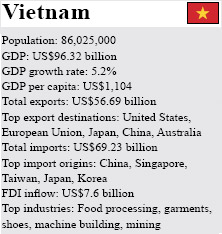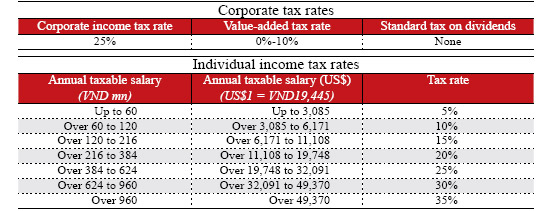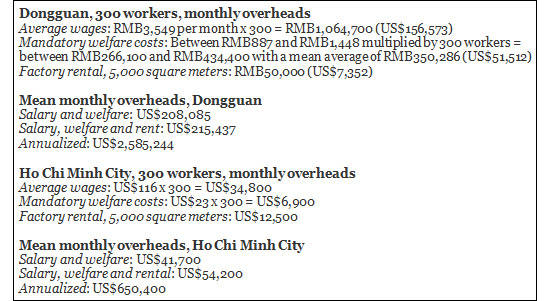From China to Vietnam for Labor Intensive, Export Driven Manufacturing
Op-Ed Commentary: Chris Devonshire-Ellis
 Dec. 9 – As the global supply chain shifts in response to an increase in China’s manufacturing costs, a rebalancing has emerged as businesses involved with labor intensive manufacturing consider where they are going to relocate to. As China is finding out, consumers in the United States and Europe do not wish to pay more for product costs, so businesses that were previously competitive with the China price are now having to look at alternatives. It’s one of the reasons our firm, Dezan Shira & Associates, established a presence in Vietnam three years ago. That decision was sparked by our noticing that labor intensive manufacturing in China’s Pearl River Delta was moving, with many of the toy and other cheap assembly plants relocating their presence to Vietnam. At the time, China’s labor law revision was still in the pipeline. Now, two years later, the impact of this has most definitely been felt. China also intends, through an annual series of incremental wage increases of 20 percent each year, to double the minimum wage payable across the country by 2015. This will further widen the labor cost gap between China and Southeast Asia.
Dec. 9 – As the global supply chain shifts in response to an increase in China’s manufacturing costs, a rebalancing has emerged as businesses involved with labor intensive manufacturing consider where they are going to relocate to. As China is finding out, consumers in the United States and Europe do not wish to pay more for product costs, so businesses that were previously competitive with the China price are now having to look at alternatives. It’s one of the reasons our firm, Dezan Shira & Associates, established a presence in Vietnam three years ago. That decision was sparked by our noticing that labor intensive manufacturing in China’s Pearl River Delta was moving, with many of the toy and other cheap assembly plants relocating their presence to Vietnam. At the time, China’s labor law revision was still in the pipeline. Now, two years later, the impact of this has most definitely been felt. China also intends, through an annual series of incremental wage increases of 20 percent each year, to double the minimum wage payable across the country by 2015. This will further widen the labor cost gap between China and Southeast Asia.
While these observations themselves are not enough to justify the relocating of an entire factory, it does mean that for those businesses whose sales market is not going to be in China, a rethink of location needs to be undertaken. Vietnam then, has plenty to offer.

What these figures actually tell us is that the average worker in Vietnam is now available at a significant discount to China. Land is also similarly priced at a discount against China. Of note also are the VAT rates, which at 10 percent in Vietnam mean far less cash flow pressure (China VAT is typically 17 percent) on operating turnover. Additionally, for businesses wishing to make a local profit, no tax on dividends. In China, dividend tax upon repatriation is 10 percent of your total profits. However, comparisons are just one aspect. As our practice is both operational in South China and Vietnam, we are able to provide on the ground research and figures that provide the real comparison data needed that only having a presence in-country can yield.
Accordingly, we’ve taken data from both Dongguan, Guangdong Province and Ho Chi Minh City to compare. We’ve used Dongguan as an example as it has long been the center for cheap China export driven manufacturing (it’s the world’s largest exporter of microwave ovens and Christmas trees, to illustrate this) and Ho Chi Minh, in South Vietnam, is more geared for export than Hanoi, is coastal, and has an efficient port and infrastructure. We’ve assumed a factory of 300 workers. Based on wage levels, mandatory welfare and commercial rentals, the comparisons look like this:

Ho Chi Minh City then provides a considerable savings over the Dongguan scenario. Even if one were to factor in the costs of severance pay in China for all 300 workers, assuming no additional liabilities were associated with the factory operations, relocating to Ho Chi Minh City would cover the severance costs of the Chinese employees in less than four months.
Clearly, the financials work out increasingly in Vietnam’s favor. That isn’t to say we’re experiencing a huge volume of companies leaving China and relocating to Vietnam. While that may be true of domestic Chinese factories, our firm’s client base is the multinational investor. These, even if extant in cities such as Dongguan, tend to be refocusing their China production to service the opportunities now beginning to emerge in the domestic China market. However, they may also be setting up an export manufacturing unit in Vietnam to continue to service their home market back in the United States for example. Of all the MNCs we have helped establish in Vietnam, about 50 percent already have a China presence, and intend on keeping it.
However, for manufacturing businesses that are looking for overseas capacity for the first time, Vietnam represents a significant discount now over similar operations in China.
Our practice in Vietnam comprises of two offices, one in each of the major cities. Hanoi, more northerly, yet inland, is geared more towards China related trade, and being the national capital is politically important. Trade with China tends to drive business and finance in Hanoi. Ho Chi Minh meanwhile has significantly improved its infrastructure and is now very capable of handling export manufacturing businesses. Tax incentives, free trade and bonded zones, together with VAT rebate schemes are all available for the cost conscious foreign investor. While China moves up the added value chain, Vietnam represents an option for serious consideration. Multinational manufacturers looking for cheaper production facilities would do well to consider investments into Vietnam as the China alternative.
Chris Devonshire-Ellis is the principal of Dezan Shira & Associates, a specialist foreign direct investment firm providing legal and tax assistance to foreign investors in both China and Vietnam. The firm has been operational in Asia since 1992, and also produces the regular business magazine Vietnam Briefing. The practices country manager in Vietnam is Hoang Thu Huyen. Please contact her at vietnam@dezshira.com for assistance or advice about establishing operations in the country.
Related Reading
 The Asia Trade, Labor and Tax Comparator
The Asia Trade, Labor and Tax Comparator
New issue: Our second annual examination and comparison of manufacturing and operational costs across 19 Asian countries
 Understanding Vietnam’s Legal Environment
Understanding Vietnam’s Legal Environment
New issue: Detailing the commercial and legal establishment regulatory environment in Vietnam
![]() Vietnam Briefing
Vietnam Briefing
Our daily news and business investment web site. Complimentary access and subscription service available.
Relocation Costs from China to India and Vietnam
Export Trade Processing in China to Become Extinct
Cambodia, Laos and Vietnam – Indochina and China Today
- Previous Article Chinese Yuan Seeks Further Internationalization and Less Reliance on U.S. Dollar
- Next Article Foreign Companies Seek Investors through Beijing Equity Exchange’s Public Program



























